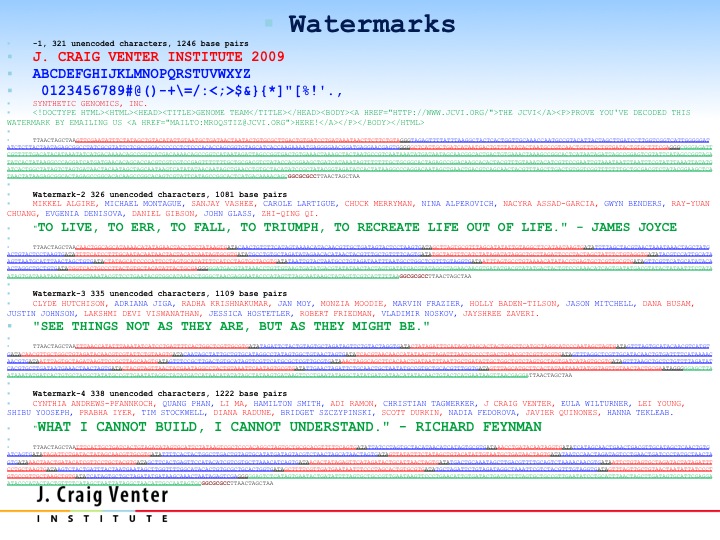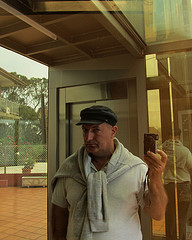Digitalizando la biología
jueves, 9 de agosto de 2012
Digitalizando la biología
De Schrödinger a Venter. Pasando por Turing y Watson. Aquí hay una conferencia de Craig Venter en Edge, celebrando los 70 años de What Is Life? de Erwin Schrödinger. Highlights:
"I will present our findings on first on reading the genetic code, and then learning to synthesize and write the genetic code, and as many of you know, we synthesized an entire genome, booted it up to create an entirely new synthetic cell where every protein in the cell was based on the synthetic DNA code."
"I view DNA as an analogue coding molecule, and when we sequence the DNA, we are converting that analogue code into digital code; the 1s and 0s in the computer are very similar to the dots and dashes of Schrodinger's metaphor. I call this process 'digitizing biology".
La vida como un procesador informático o máquina de Turing:
"Turing described what has become to be known as Turing Machines. The machine described a set of instructions written on a tape. He also described the Universal Turing Machine, which was a machine that could take that set of instructions and rewrite them, and this was the original version of the digital computer. His ideas were carried further in the 1940s by John von Neumann, and as many people know he conceived of the self-replicating machine. Von Neumann's machine consisted of a series of cells that uncovered a sequence of actions to be performed by the machine, and using the writing head, the machine can print out a new pattern of cells, allowing it to make a complete copy of itself on the tape. Many scientists have made the obvious analogy between Turing machines and biology. The latest was most recently in nature by Sydney Brenner who played a role in almost all the early stages of molecular biology. Brenner wrote an article about Turing and biology, and in this he argued that the best examples of Turing and von Neumann machines are from biology with the self-replicating code, the internal description of itself, and how this is the key kernel of biological theory."
Sobre cómo hacer vida sintética:
"Starting with the digital code we synthesized DNA fragments and assembled the genome. We corrected the errors and in the end had a 5,386-basepair piece of DNA that we inserted into E. coli, and this is the actual photo of what happened. The E. coli recognized the synthetic piece of DNA as normal DNA, and the proteins, being robots, just started reading the synthetic genetic code, because that's what they're programmed to do. They made what the DNA code told them to do, to make the viral proteins. The virus proteins self-assembled and formed a functional virus. The virus showed its gratitude by killing the cells, which is how we effectively get these clear plaques in a lawn of bacterial cells. I call this a situation where the "software is building its own hardware". All we did was put a piece of DNA software in the cell, and we got out a protein virus with a DNA core."
"How do you boot up a synthetic chromosome in a cell? This took substantial time to work out, and this paper that we published in 2007 is one of the most important for understanding how cells work and what the future of this field brings. // This paper is where we describe genome transplantation, and how by simply changing the genetic code, the chromosome, in one cell, swapping it out for another, we converted one species into another."
"When we interrogated the cells, they had only the transplanted genome, but more importantly, when we sequenced the proteins in these cells, there wasn't a single protein or other molecule from the original species. Every protein in the cell came from the new DNA that we inserted into the cell. Life is based on DNA software. We're a DNA software system, you change the DNA software, and you change the species. It's a remarkably simple concept, remarkably complex in its execution."
Mensajes inscritos en el genoma de las primeras células sintéticas a modo de marcas de agua:

"One of the ways that we knew that what we had was a synthetic cell was by watermarking the DNA so we could always tell our synthetic species from any naturally occurring one. Now about the watermarks, when we watermarked the first genome we just used the single letter amino acid code to write the authors names in the DNA. We were accused of not having much of an imagination. For this new genome we went a little bit farther by adding three quotations from the literature. But first the team developed a whole new code where by we could write the English language complete with numbers and punctuation in DNA code. It was quite interesting. We sent the paper to Science for a review, and one of the reviewers sent back their review written in DNA code, much to the frustration of the Science editor, who could not decipher it. (Laughter) But the reviewer's DNA code was based on the ASCII code, and with biology that creates a problem because you can get long stretches of new without a stop codon. We developed this new code that puts in very frequent stop codons, because the last thing you want to do is put in a quote from James Joyce and have it turn into a new toxin that kills the cell or kills you. You didn't know poetry could do that, I guess. // We built in the names of the 46 scientists that contributed to the effort, and also there was a message with an URL. So being the first species to have the computer as a parent, we thought it was appropriate it should have its own Web addressed built into the genome. As people solved this code, they would send an e-mail to the Web address written in the genome. Once numerous people solved it, we made this available."
La segunda cita viene de American Prometheus, de Oppenheimer.
"All living cells that we know of on this planet are DNA software driven biological machines comprised of hundreds to thousands of protein robots coded for by the DNA software. The protein robots carry out precise biochemical functions developed by billions of years of evolutionary software changes."
"We can digitize life, and we generate life from the digital world. Just as the ribosome can convert the analogue message in mRNA into a protein robot, it's becoming standard now in the world of science to convert digital code into protein viruses and cells. Scientists send digital code to each other instead of sending genes or proteins."
"I suggested in place of sending living humans to distant galaxies that we can send digital information together with the means to boot it up in tiny space vessels. More importantly and as I will speak to on Saturday evening synthetic life will enable us to understand all life on this planet and to enable new industries to produce food, energy, water and medicine as we add 1 billion new humans to earth every 12 years."
La primera idea ya la planteó Olaf Stapledon al final de Last and First Men. La segunda es excelente, pero la solución al crecimiento de la población ha de venir por otro lado. Ahora que el colofón de la conferencia lo pone Watson, de Watson y Crick:
"I think chemistry is a good thing. I think our finding the DNA structure was unusual in that Crick or I, neither of us knew any chemistry. Luckily there was a chemist in the room, and helped."
Quizá no esté de más recordar en este contexto a Herbert Spencer, que a medidados del siglo XIX ya definió la vida como un proceso químico autorreproductivo de alta intensidad y rendimiento. Sin poder describirlo en más detalle, claro, al faltarle los elementos, el lenguaje y el código, al estar la química en mantillas, y la informática por inventar.
Curso sobre biología evolutiva en Yale

0 comentarios